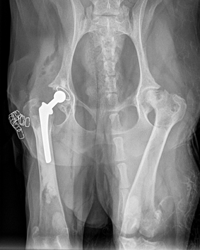News
Total Hip Replacement in Dogs
by admin on June 1st, 2015
Category: News, Tags:
 Hind limb (back leg) lameness is a common reason small animal patients present to a veterinary surgeon. This is a more frequent scenario in dogs but we also see cats with this type of lameness. The causes of hind limb lameness are varied, but hip pain is a frequent reason for our patients to become lame.
Hind limb (back leg) lameness is a common reason small animal patients present to a veterinary surgeon. This is a more frequent scenario in dogs but we also see cats with this type of lameness. The causes of hind limb lameness are varied, but hip pain is a frequent reason for our patients to become lame.
What causes hip pain in dogs?
There are many causes of hip pain, however hip dysplasia, and the subsequent development of osteoarthritis, is the most common condition leading to this in dogs. This condition is also recognised in cats. In smaller dogs with hip pain, commonly terrier-type or poodle-type breeds, a condition called ‘avascular necrosis of the femoral head’ or ‘Legg Calvé Perthes disease’ can be diagnosed. Some of these patients will respond to medical therapy, but what happens if the lameness and the pain persist despite appropriate medication?
Can surgery help?
In patients where medical therapy does not control the lameness or pain, surgery can be considered. In many of these cases, the changes in the hip joint are severe and there is no chance of a corrective surgical procedure being successful. We therefore look at surgical salvage procedures to help reduce pain and ideally improve limb function. The two main surgical procedures for the hip joint are ‘femoral head and neck excision arthroplasty’ (also called femoral head ostectomy – FHO) and ‘total hip replacement’ (THR).
Femoral head and neck excision arthroplasty
Femoral head and neck excision arthroplasty is where the femoral head (the ‘ball’ part of the ball and socket joint) is removed and a false joint is allowed to form. This can reduce pain and is a reasonable treatment option. However, limb function is not always good and in one study limb function was considered poor in over 40% of cases.
Total hip replacement
Our aim should be not only to improve comfort, but also to improve limb function as best we can. This can be achieved with total hip replacement. This is where the femoral head is removed and replaced with a metal ball and the socket (the ‘acetabulum’) is replaced with a plastic cup.
This procedure has a high success rate and can improve limb function to near normal. It has historically been recommended in large dogs but we now know that smaller dogs can benefit from this procedure and the implants have been manufactured small enough to use in small breed dogs and in cats.
There are several different systems available. The main differences between the systems are whether the implants are secured with cement or not – what we term ‘cemented’ or ‘cementless’ systems.
Questions to ask if you think your dog needs a hip replacement…
Is total hip replacement the best option for my pet?
All surgical procedures carry risk and total hip replacement in dogs is no different. The complication rate is approximately 10%, so the risks of surgery need to be weighed against the potential benefits. If there is a painful lameness that is poorly responsive to medical treatment including weight control, exercise control and painkiller medication, a total hip replacement is generally indicated.
Is there a reason why my pet may not be a candidate for surgery?
Infection elsewhere in the body (skin, ear or gums) can increase the risk of infection of the total hip replacement. If surgery has been performed on the hip previously, total hip replacement may not be appropriate or can carry a higher complication risk. An immature skeleton may prevent total hip replacement from being performed although recent evidence shows this is technically possible. Maturity of the skeleton often occurs between 8-12 months. The procedure is generally expensive and cost may prohibit this surgery for some owners.
Who will be doing the surgery?
Total hip replacement is a highly skilled procedure. It should ideally be performed by a surgeon(s) with appropriate level training and good levels of experience. It is important, as a pet owner, that you are as informed as possible before making a decision to have a total hip replacement performed and the bond between a surgeon and pet owner is very important. As a pet owner in the UK, you can request to be referred to whichever clinic you wish.
Can complications occur with total hip replacement?
In short, yes. The complication rate for this procedure is generally low, meaning that a high number of patients have an uneventful recovery period. The main complications for this procedure are infection and luxation (dislocation). Other complications are rare but include fracture of the femur, sciatic nerve problems, implant loosening and embolism at the time of surgery.
What aftercare is required after total hip replacement?
Your pet will require a significant period of rest after surgery (usually several weeks) followed by gradually increasing levels of lead exercise and then off-lead activity over several months. This should be discussed with your surgeon in detail prior to surgery.
What is the prognosis for my pet?
This is a procedure which can significantly improve the life of patients with chronic hip pain. Some owners report dramatic changes in not only the way that their pet uses the limb but also in the patient’s quality of life. A good to excellent outcome is expected in most patients.
Responses are currently closed, but you can trackback from your own site.
